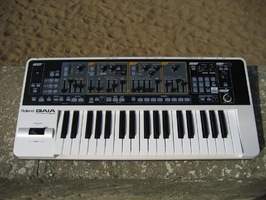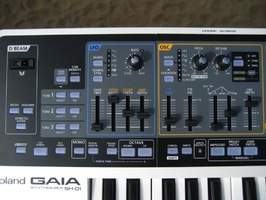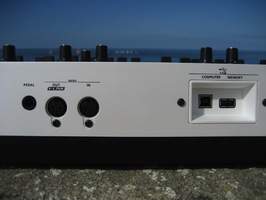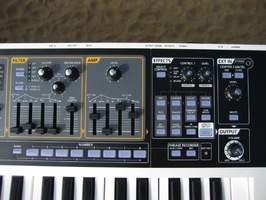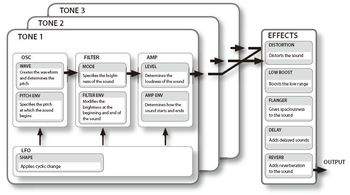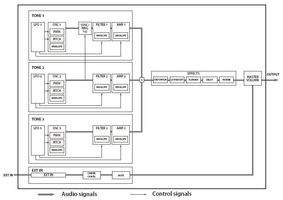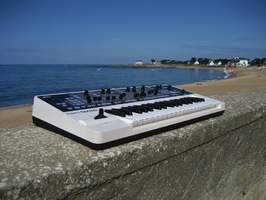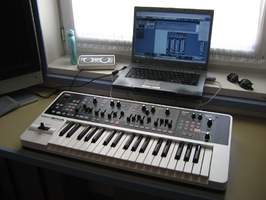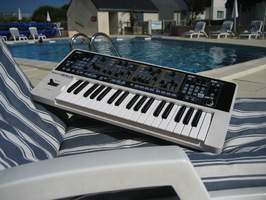The SH-01 is Roland's answer to the analog modeling synths market where low budget and ergonomics are not compatible. Let's see what tradeoffs were made to combine ease of use and a competitive price.
Since the SH-1000 was launched in 1973, the SH series is without a doubt the most comprehensive among the whole product range of the Japanese manufacturer. Modern SH models are very different from their ancestors: they are programmable, digital, polyphonic, incorporate Midi, etc. Their name has more to do with a marketing concept than a sound concept. However, they focus mainly on direct-access controls and are meant to be immediate and easy-to-use instruments. Since the Nord Lead from 1995, the glorious times of modeling synths are way behind us. Japanese heavyweights have partially withdrawn into themselves while Americans don’t move forward anymore and Europeans try to amortize their R&D costs. The market became bipolar: at the top, the quiet kingdom of the Nord Lead, Virus, Origin, Accelerator, and Solaris that changes very slowly; at the bottom, the merciless world of cost killers like the Korg Micro & R3, Blofeld, SH-201, Miniak, etc. These instruments are often affordable but don’t provide the best ergonomics and manufacturing quality. With the SH-01 “Gaia, ” Roland wants to enhance the ergonomics absent in budget products. Compromises had to be made. Were they wise decisions?
Easy Handling
The SH-01 is a compact synth with a standard, velocity-sensitive, 37-note keyboard (three octaves). It is easy to transport and it runs on a power supply or batteries (the manufacturer says battery life is 4–5 hours). This summer, we took it along with a notebook to the sunny French beaches to test it while getting tanned. The black and white plastic housing isn’t as cheap as it seems. It seems to have some sort of reinforcement and it endured rough handling pretty well. The instrument is an invitation to tweaking. Its front panel is packed with clear, ergonomic and logically implemented control elements. Handling is easy with any synthesis form because you can understand the signal and modulation paths right away: D-Beam controller, LFO, oscillator, filter, amp, effects, etc. The 18 envelope sliders and 11 rotary controls recall the design of the prestigious Jupiter-8 or JP-8000. The rotary controls are not screwed down but they are well secured anyway. On the contrary, the sliders with plastic heads are fragile. It is very disappointing that in today’s modern digital era, controls only seem to to “jump, ” because this limits their use in live performances.
A “Bank” key plus eight dedicated keys allow you to select the 2 × 64 ROM and RAM programs (RAM is for user presets). Editing arpeggios and sequences is harder because controls are reduced to their simplest expression. Many commands use key combinations using the shift button, and many functions are not written on the front panel, which is a serious design flaw in our eyes… To use the SH-01 in real time, you get an optical D-Bean controller you can assign to many synthesis parameters, a pitch+modulation joystick (typical of the manufacturer) and an assignable port for a foot controller. The unit offers some valuable direct performance controls: tap tempo, octave transpose and V-link for image/slide-show control with compatible devices. A “Manual” control allows reckless sound designers to start programming from the position of the physical control itself, or they can start by reseting all parameters all at once.
USB Gets the Place of Honor
The rear panel makes a very good impression (except for the usual external power supply): stereo audio output and phones output on 1/4" jacks, versatile assignable 1/4" TRS input for a foot controller, Midi in/out, and a dual USB port. The USB ports allow you to connect the SH-01 to computers and storage devices, which is rather unusual for a device in this price range. Even better: the “Host” USB port allows bidirectional Midi and audio data transfer with a computer (drivers are provided on the CD-ROM) for direct audio recording into a host application without quality loss. It also allows you to route the audio mix of the host application to the SH-01 analog outputs. We chose this solution for the sound samples in this review… The device can also send the computer the audio signal feeding the stereo minijack on the front panel. This signal can be processed within the SH-01. You can mute it, attenuate it and cut frequencies according to three modes: high/mid frequencies (to suppress vocals and solo parts of a song, for example), low frequencies and full range. On the contrary, it is not possible to route the input signal to the internal filters and effects. (We are still wondering why the device has this frustrating limitation.)
The other “Media” USB port is conceived for connecting external storage units, (like a USB key) to save and exchange user data (programs, patterns). But there is a fly in the ointment: on the one hand, the USB key can only hold 64 programs + 8 patterns (i.e. some kilobytes) regardless of the memory size of the key. What a waste! On the other hand, a “hot connection” is not possible, which means that you have to power off the device before disconnecting/connecting. No comments… Finally, we have to mention that the SH-01 cannot be USB powered, in spite of its minimum power requirements (9 V – 600 mA), which could be perfectly supplied through the USB port.
Triple Layers
The SH-01 is mainly an analog modeling synth (VA) with direct access. It also includes a PCM section with GM2 support along 15 Midi channels. This section can be controlled and edited from an external unit via a SMF-type sequence, which you cannot store in the device. This section has the quality of a budget Sound Canvas of the 90's. Don’t ask too much of it… The VA programs provided in the ROM sound very (even too) typically techno. We created some simple analog-like sounds to highlight the personality of the SH-01. With its multi-filters and three layers, the SH-01 gives good results for pads. But as soon as high-frequencies are not attenuated (open LP filter or closed HP filer), the sound becomes aggressive and unpleasant. You can get round bass sounds — especially with the booster effect — but with a lack of punch because of the much too soft envelopes. The three layers and the modulated pan allow you to create convincing organ sounds if you dedicate a layer to the percussion. For bell sounds, the ring modulation works wonderfully in combination with the pitch shift and ping-pong delay effects: a Saint Peter’s Basilica feel isn’t hard to get… Adding the sync function emphasizes the digital and aggressive sound color of the SH-01 with easily audible aliasing. When you turn sync off, you’ll appreciate the quality of the high-frequency oscillators, with aliasing appearing only in the higher octaves… not too annoying!
The SH-01 provides up to 64 voices of polyphony. Each VA program includes one to three tones that are mixed before reaching the global effects section and the output. Each tone is a comprehensive synth with one oscillator, one filter and one amp modulated by three envelopes and two LFOs (see program structure synopsis). Each tone equals one polyphony voice, thus a program that includes two oscillators has 32 voices of polyphony, which is very comfortable. For VA synthesis, the device is monotimbral and has no split function… outrageous! If you use the same filter settings for both oscillators, you’ll use one filter “for nothing.” Once again, what a waste. It is all the more annoying given that all three tones are fully independent, which means that you cannot use the LFO of the first one to modulate the second one in case of need. The tones can be easily edited together or separately thanks to the three selection keys. Other keys allow you to mute them on the fly. You can easily copy the parameters of a tone and paste them to another one as long as you stay in the same program. It would be great that this function extended to all programs. We can only hope for a future OS update, although the manual doesn’t specify at this stage how that would be possible…
Seven Waveforms
In the beginning of the tone, there was the oscillator. The SH-01 provides seven waveforms: sawtooth, square, variable width pulse, triangle, sinus, noise, and supersaw. By the way, a program with two oscillators plus noise requires three tones. The waveforms cannot be played simultaneously (just like on a Jupiter-8!). There are three variations per wave including different harmonic content. This discontinuous parameter cannot be modulated. The PWM waves disappointed me a lot: the value range is very short, it is not centered on the square wave and the sweep doesn’t sound very musical. The same applies to the three Supersaw wave variations: they are made out of multisamples and you can actually hear some transitions and loops. They become hardly usable when heavily transposed. Use them only for techno stabs with delay!
The oscillators of the two first tones can interact via syncing or ring modulation, but not both at the same time. This interaction has a very high price: first of all, the sync deactivates the filter for the first oscillator and forces the SH-01 into mono mode; and second, the pulse width of the square waves cannot be modulated anymore (and we are still wondering why!). By the way, the pulse width can be modulated only by the LFO, the D-Beam or the foot controller, but not by the envelopes or anything else… The oscillator frequency can be modulated by a dedicated AD envelope with bipolar modulation, which is enough for classic sync sweeps. You’ll also find a programmable portamento mode.
Resonant Multimode Filter
The oscillator output is connected to a resonant, self-oscillating multimode filter. It is very comprehensive and provides low-pass, high-pass, band-pass and peak modes (the peak mode emphasizes a given frequency range without affecting other frequencies). You can also choose the cutoff slope (two or four poles). With the resonance in four-pole mode, the filter sounds very harsh and not musical at all. It can even hurt your ears. Keyfollow is bipolar from –2 to +2 in one cent steps, which makes fine tuning possible. The cutoff control is not the most precise in the market and it generates easily audible step effects sometimes.
A bipolar ADSR envelope is hard assigned to modulate the cutoff. We have already mentioned that its velocity is much too slow. It can be controlled by the velocity, which requires a combination of the [Shift] + [Cutoff] keys to edit the parameter. It would be much better if this function was silk screened on the unit! Behind the filter, the signal goes through an amp controlled by an ADSR envelope which is as soft as the filter envelope. This envelope cannot be modulated. In fact, only the volume is directly modulated by the velocity through the [Shift] + [Level] key combination which, once again, would be acceptable if the function was silk screened on the unit! The pan can also be adjusted with a key combination ([Shift] + [Detune]), which would be acceptable if…
Limited Modulations
Let’s be clear: the SH-01 is no modulation champion! Each tone has an LFO with six waveforms including S&H and random modes. It can work independently on the pitch, the filter, the volume, and the pan. For this last parameter, you’ll have to use, once again, a key combination ([Shift] + [Amp Depth]. This would be acceptable if…! You can adjust the attack time of the modulation and the tempo, which can be synced to the internal/Midi clock. The modulation controller commands a second independent LFO with the same parameters (except modulation attack) and the same destinations. To control this LFO, use the controller while pressing [Shift].
As we already mentioned before, each tone is independent, i.e. the LFO or the envelope of a tone cannot modulate another tone. This three-tone parallel structure would be pertinent if it were possible to combine the filters/amp on different ways like in the V-Synth series. But it’s not the case and, once again — like the lack of multitimbrality depending on the polyphony —, it is a big DSP waste without any noticeable sound quality improvement. We won’t talk about a modulation matrix because there is none, except for the D-Beam and foot controller that can be assigned to synthesis parameters. All other parameters are fixed to improve ease of use…
Sequences and Arpeggios
In return, you get an arpeggiator that works globally for each program and provides 64 non-programmable arpeggios. There are basic patterns (up, down, alternate) which are more or less complex (variable modulations, polyphonic chords, etc.). Just select an arpeggio, play a chord and maintain it if you want and that’s it… simple — ubersimple! You’d think that the phrase sequencer will be of help. Unfortunately, it has only eight global memories of eight bars maximum. This means that you won’t even have one different sequence per program! This basic sequencer allows you to record notes and front-panel control movements in real time only. Just start the recording, use the controls and that’s it. If that’s not enough, you can do some basic editing in real time: global delete, note delete, pitch bend/modulation message delete, or front-panel control movement delete. When you play, the sequencer only provides on/off functions and nothing else. Next!
Effects Times Five
Behind the amp output, the mix of the three tones can be programmed and sent to a stereo effects section providing five simultaneous effect families: distortion, ensemble, delay, reverb, and bass boost. Distortions are insert effects ranging from classic saturation to typical digital-bit crusher. They can be fun with some solo instruments if you like digital sound. The ensembles are parallel effects including standard flanger, phaser and pitch shifter but no chorus. The delay effect can be synced to the internal/Midi clock, it provides stereo and ping-pong modes with internal/Midi clock sync. Very useful! The reverb (parallel as well) provides three algorithms: room, plate and hall. It doesn’t sound wonderful but is quite useful if you don’t overemphasize high frequencies. Each effect includes four adjustable parameters you can control with two knobs and the famous [Shift] key we hadn’t mentioned for a couple of lines. No parameter can be modulated in real time. Last but not least, the low-boost effect will amplify the bottom end to please earthquake fans. The effects section’s sound quality is quite good and it is very useful. Its integration into the synthesis section of the programs is well done.

- Basses00:30
- Bells00:26
- Leads00:24
- Wind00:22
- Pads 300:31
- Arpeg00:56
- Pads 100:39
- Pads 200:35
- Organ00:20
- Sync00:17
Mixed Impressions
In the end, the SH-01 left us with mixed impressions. This affordable standalone instrument is easy to use, includes a real dynamic keyboard and is more sturdy than it seems. With its numerous controls and not very versatile signal path, it was clearly conceived for beginners. However we don’t quite understand why so much DSP power is wasted with three fully independent signals instead of letting them interact. The same applies to the very generous polyphony in detriment of multimbrality for the VA section, and to the three multimode filters and five effect DSPs which can’t be assigned to the external signal source. USB provides you deluxe bidirectional audio transfer but a lousy management of mass storage units. The sound is less controlled than on the 1997 JP-8000. It shows an overall lack of consistency and punch, and tends to become aggressive as soon as high frequencies are not cut. Its very attractive price makes the SH-01 a great instrument to discover subtractive sound synthesis without risks.
- Attractive price
- Battery operation
- Compact size
- Easy handling
- Audio & Midi over USB
- Full-size dynamic keys
- Generous polyphony
- Effects section
- Sound is not very consistent and it tends to be aggressive
- VA section is monotimbral
- Mono in sync mode
- Very limited modulation possibilities
- Very basic arpeggiator/sequencer
- No external audio signal processing
- Silkscreen does not mention shift functions
- USB storage unit management
- OS could be greatly improved
- Rather toyish PCM

